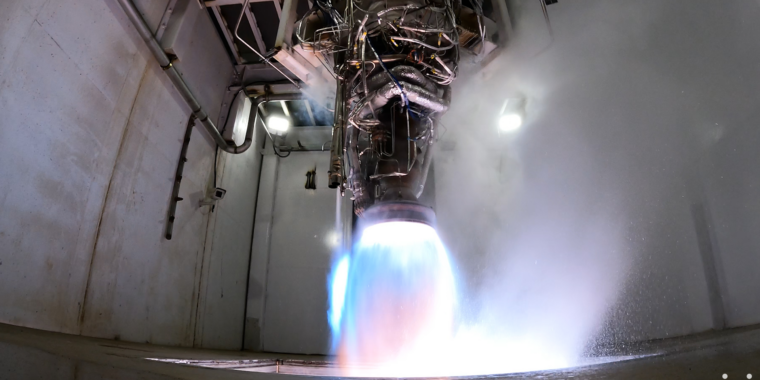
Relativity Space
Relativity Space intends to use the small Aeon 1 engine it is developing to power its first rocket for only a few flights. Instead, the company plans to quickly perform a “block upgrade” for the Terran 1 rocket, which will serve as a bridge to the much larger, more capable Terran R rocket.
“We’ve always envisioned Terran 1 being a development platform,” said Tim Ellis, the co-founder and chief executive of Relativity Space, in an interview with Ars.
The California-based company, which seeks to 3D-print the majority of its rocket parts, is continuing to work toward the first launch of Terran 1 this year. Powered by nine Aeon 1 rocket engines, this small rocket has a lift capacity of 1.25 metric tons to low Earth orbit. This first Terran 1 mission will not carry any customer payloads in order to focus on the rocket itself and is called “Good Luck, Have Fun.” The name is a reference to what players say to one another before a video game begins, Ellis said.
The second flight of Terran 1 will carry a “Venture Class Launch Services” small satellite payload for NASA, awarded by the space agency in 2020 to support US-based small launch companies. The third Terran 1 mission also has a customer, but Relativity has not yet disclosed it.
Following these three demonstration flights, Relativity plans to upgrade the Terran 1 rocket by moving from a nine-engine configuration to just a single Aeon-R engine. This engine, nine of which will eventually power the reusable Terran R rocket, is projected to have about 300,000 pounds of thrust, or more than 10 times that of the Aeon-1 engine. This upgrade will provide Relativity with a more capable small launch vehicle, for less cost, with commonality on the Terran R rocket, Ellis said. It also satisfies the company’s goal of reducing part counts. For example, instead of nine engines and 18 turbopumps, the upgraded Terran 1 would use one engine and two turbopumps.
So why didn’t Relativity just start with a Terran 1 rocket powered by a single Aeon-R engine?
Building an initial rocket with nine smaller engines was “definitely not the optimum choice in hindsight to get to orbit as simply and quickly as possible for the Terran 1 program,” Ellis said. “But it’s been part of our plans to do a much larger reusable rocket for a long time. So we chose to do liquid oxygen and liquid methane engines as well as the nine-engine configuration on Terran 1 so that we could learn as a company how to do something that complex early on, before we had to go build this 20,000 kilogram payload-to-orbit vehicle.”
That larger, futuristic Terran R rocket will have a reusable first and second stage, which Ellis believes will allow his company to compete with SpaceX’s Falcon 9 rocket for commercial launches. Ellis said there is a lot of interest in Terran R since it was publicly announced last year, with one customer already on board and “quite a few more” expected to close on deals during the next six months. The Terran R may make its first flight in 2024.
While Relativity’s goal is getting to the Terran R, Ellis said the company has no plans to abandon the Terran 1 rocket. Relativity has the capital to carry both programs forward—after recent fundraisers, Ellis said Relativity has nearly $1 billion cash in the bank—and the large 1-million-square-foot factory it is building in Long Beach will support both vehicles.
“We’re still very, very focused on becoming an orbital company and getting Terran 1 to orbit this year,” Ellis said. “But simultaneously, I can say we’re very deep into Terran R development.”
The company also has the work force to support both projects. When I first spoke to Ellis four years ago, the company had 17 employees. Now it has a work force of 700 people and continues to grow.
Engineers and technicians at Relativity are finalizing integration work on the first and second stages of the first Terran 1 rocket to launch. The second stage will soon ship to Stennis Space Center in Mississippi for tests. Ellis said the Aeon 1 engines have completed acceptance testing. He seemed confident that the company would be ready for “Good Luck, Have Fun” to launch this year from a launch site at Cape Canaveral Space Force Station in Florida.
“We are definitely launching this year,” he said. “Yeah, we are definitely launching this year. I have no doubt about that one at this point, barring an act of nature or something going seriously wrong in stage testing.”








